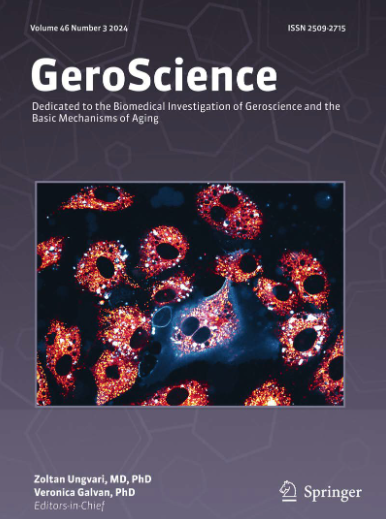一项全基因组关联研究确定了表观遗传年龄加速的亚洲特异性遗传易感性。
IF 5.4
2区 医学
Q1 GERIATRICS & GERONTOLOGY
引用次数: 0
摘要
为了了解表观遗传年龄加速(EAA)的遗传基础,研究人员对多个表观遗传时钟进行了全基因组关联研究(GWASs)。为了探索亚洲人群的种族差异和个体差异,我们在韩国人群中使用多个表观遗传时钟进行了EAA的GWAS。获得了1962名韩国人的全基因组单核苷酸多态性(SNP)和甲基化数据。考虑了5种表观遗传时钟(Hannum, DNAm PhenoAge, GrimAge, Zhang2019和Horvath-Skin&Blood)。通过GWASs、基于基因的途径富集、实时定量聚合酶链反应和定量性状位点分析来研究其生物学机制。利用多效分析和药物再利用来探讨临床意义。6个snp与eaa独立相关(P < 5 × 10-8)。DNAm表型- eaa与ASPA和SPATA22相关(P < 2.66 × 10-6),参与Canavan病和细胞凋亡;Zhang2019与ENO2、GNB3、USP5、TPI1和CDCA3相关(P < 2.66 × 10-6),参与单糖分解代谢。尤其是SPATA22、ENO2、USP5和TPI1在衰老细胞中的表达水平升高。eaa相关基因与过氧化物酶体增殖物激活受体-β/δ (PPAR-β/δ)激动剂GW0742有很强的亲和性。此外,zhang 2019- eaa相关SNP在肝功能生物标志物(包括铁和胆红素)中表现出多效性。我们确定了6个亚洲特有的eaa相关遗传变异,包括5个新的snp。这些在欧洲人群中罕见的新snp可能暗示了表观遗传衰老中与祖先相关的遗传差异。此外,DNAm表型-EAA和Zhang2019-EAA在东亚人群中对细胞凋亡和肝功能的遗传意义可能有助于更好地了解EAA。本文章由计算机程序翻译,如有差异,请以英文原文为准。
A genome-wide association study identifies Asian-specific genetic susceptibility for epigenetic age acceleration.
Genome-wide association studies (GWASs) have been performed on multiple epigenetic clocks to understand the genetic underpinnings of epigenetic age acceleration (EAA). To explore ethnic differences and individual variability in Asian populations, we conducted a GWAS of EAA using multiple epigenetic clocks in the Korean population. Genome-wide single-nucleotide polymorphism (SNP) and methylation data were obtained from 1962 Korean individuals. Five epigenetic clocks (Hannum, DNAm PhenoAge, GrimAge, Zhang2019, and Horvath-Skin&Blood) were considered. GWASs, as well as gene-based, pathway enrichment, quantitative real-time polymerase chain reaction, and quantitative trait loci analyses, were performed to investigate the biological mechanisms. Pleiotropy analyses and drug repurposing were used to explore clinical implications. Six SNPs were independently associated with EAAs (P < 5 × 10-8). The DNAm PhenoAge-EAA was associated with ASPA and SPATA22 (P < 2.66 × 10-6), involved in Canavan disease and apoptosis, and the Zhang2019 was associated with ENO2, GNB3, USP5, TPI1, and CDCA3 (P < 2.66 × 10-6), which are implicated in monosaccharide catabolism. Particularly, the expression levels of SPATA22, ENO2, USP5, and TPI1 increased in senescent cells. EAA-associated genes showed strong affinities with GW0742, a peroxisome proliferator-activated receptor-β/δ (PPAR-β/δ) agonist. In addition, the Zhang2019-EAA-associated SNP showed pleiotropy in liver function biomarkers, including iron and bilirubin. We identified six Asian-specific EAA-associated genetic variants, including five novel SNPs. The novel SNPs, which are rare in European populations, could implicate ancestry-related genetic differences in epigenetic aging. Furthermore, the genetic implications of the DNAm PhenoAge-EAA and Zhang2019-EAA on apoptosis and liver function may contribute to a better understanding of EAA in East Asian populations.
求助全文
通过发布文献求助,成功后即可免费获取论文全文。
去求助
来源期刊

GeroScience
Medicine-Complementary and Alternative Medicine
CiteScore
10.50
自引率
5.40%
发文量
182
期刊介绍:
GeroScience is a bi-monthly, international, peer-reviewed journal that publishes articles related to research in the biology of aging and research on biomedical applications that impact aging. The scope of articles to be considered include evolutionary biology, biophysics, genetics, genomics, proteomics, molecular biology, cell biology, biochemistry, endocrinology, immunology, physiology, pharmacology, neuroscience, and psychology.
 求助内容:
求助内容: 应助结果提醒方式:
应助结果提醒方式:


